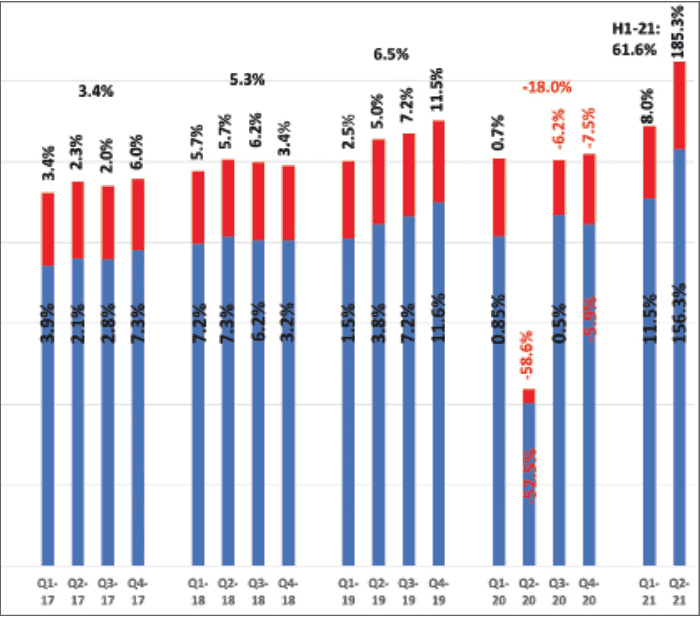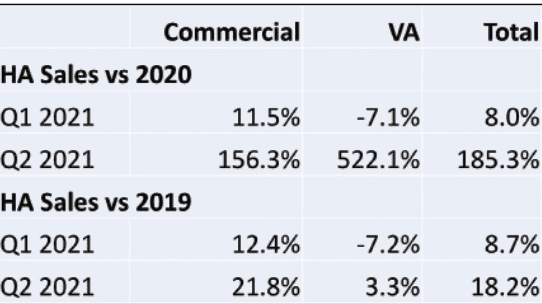Staff Standpoint| September 2021 Hearing Review
By Karl E. Strom
Even though any comparison of today’s US hearing aid sales to those of 2020 is bound to involve gaudy numbers—recall that total sales fell by more than half (58.6%) in the second quarter of last year due to the pandemic—statistics from the Hearing Industries Association (HIA) confirm a big comeback. For the first half (H1) of 2021, net unit sales rose by 61.6% when compared to H1 2020, and by 13.5% when compared to the pre-pandemic period of H1 2019.
Last year, total year-end US net unit sales were 18.0% below those of 2019 due to Covid-19 and the reluctance of older adults to visit hearing care offices (Figure 1). Private-practice and commercial market dispensing decreased in unit volume by -14.2% and by -34.0% at the VA.

Figure 1. US net hearing aid unit quarterly sales from 2017 to the present, with blue bars representing private/commercial sector sales and red bars representing VA dispensing activity. All percentages reflect gains/losses over the same period from the previous year, with commercial percentage gains shown within the blue bars. Figures at the top are total y-o-y annual and quarterly unit volume sales gains/losses. Source: HIA.
Things are decidedly brighter today. Total hearing aid sales increased by 8.0% in the first quarter of 2021, followed by a 185.3% increase in the second quarter (against the 58.6% decrease in Q2 2020) as inoculation rates of US adults ages 65+ have exceeded 80%. When comparing this year’s statistics to those in pre-pandemic 2019, net unit hearing aid sales rose by 8.7% and 18.2% for Q1 and Q2 2021, respectively (Table 1). In other words, it currently appears that pent-up demand may make the 2020 pandemic a “blip”—albeit a very painful and memorable blip— in the historical progress of hearing aid adoption and market growth.
Private practice and commercial businesses (including mass retailers) were more resilient than the dispensing activity of the US Department of Veterans Affairs (VA), both during and as we emerge from the pandemic. Hearing aid sales in the commercial market rose by 11.5% and 156.3% in the first two quarters of 2021 compared to last year, respectively. When compared to Q1-Q2 2019, commercial sales in 2021 were 12.4% and 21.8% higher, respectively.
Because of its unique patient population and other factors, the VA has been slower to recover from an almost-complete shutdown of dispensing activity during the second quarter of last year (-83.4% decrease vs Q2 2019), followed by decreases of -34.5% and -14.7 in Q3 and Q4 2020, respectively. Hearing aid dispensing continued to improve in the first quarter of 2021 with a -7.1% decrease compared to 2020, then shot up by 522.1% in the second quarter—even surpassing VA sales from the pre-pandemic levels of 2019 by 3.3%.

Table 1. Comparison of 2021 first- and second-quarter hearing aid unit sales with those of 2020 and 2019. Source: HIA.
What’s ahead? The bottom line is that 2021 is shaping up as an excellent recovery year, with much of the speculation about possible “pent-up demand” being vindicated. When comparing first halves, total US net unit hearing aid sales in 2021 are 13.5% above 2019 pre-pandemic sales, with the commercial market increasing by 17% and the VA with a shortfall of -1.7%. Should hearing aid sales continue at a pace around 10% above 2019 levels, year-end hearing aid unit volume would approach or exceed 4.7 million units—representing a 36% increase over last year and a 12% increase over 2019. Of course, this all depends on our continued thwarting of the coronavirus (including the Delta variant) and emergence from the recession it produced.
Citation for this article: Strom KE. US hearing aid sales roar back. Hearing Review. 2021;28(9):6.





